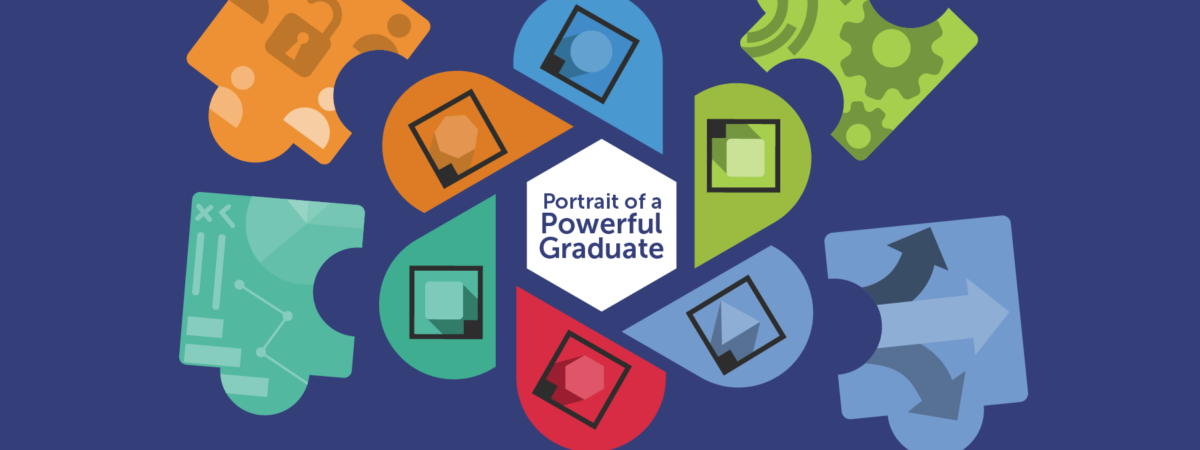
Portrait of a Graduate defines dispositions and abilities that will lead to students’ well-being, fulfillment, and economic security. School districts across the nation typically identify six common attributes that students should embody and exemplify by high school graduation. However, these commonly identified dispositions, such as “creating to solve and share” are interconnected and crosscutting, and do not directly correlate to current methods of assessment and credentialing, including grades and standardized tests. These traditional systems also fall short in recognizing the depth of skill and expertise that historically and systematically excluded learners develop inside and outside of formal education.
Digital Promise is developing innovative solutions to support learners to be recognized for these essential skill sets in K-12 education and beyond. Student-level competency-based digital badges (micro-credentials) and interoperable data infrastructure (e.g., Learning and Employment Record (LER) technologies) can enable learners to:
Read on to learn more about Learner Micro-credentials and Learning and Employment Records (LERs).
Micro-credentials recognize and share information about specific skills a learner has acquired. To earn a micro-credential, learners must submit evidence that they have demonstrated a specific skill, which is evaluated by an external party. Micro-credentials are particularly useful for capturing attributes in Portrait of a Graduate because they highlight specific competencies the learner acquires that are not represented by a grade or course completion. Micro-credentials place the learning experience in the hands of the learner through competency-based assessment, certifying the learner can demonstrate a specific skill. (Staker, Arnett, & Powell, 2020). Learners can also quickly upskill or reskill without the time and financial commitments.
Learning and Employment Records have emerged as a solution to capture the skill sets that learners acquire both in and outside of school. LERs provide a complete picture of a learner aside from course titles, credits completed, and grades earned by capturing co-curricular and extracurricular activities, internships, club involvement, and employment— details that are not part of the standard transcript.
By capturing formal and informal experiences, LERs allow learners to better identify strengths and areas of growth in their industry-aligned career pathway. They offer the potential to connect graduates to support, opportunities, portfolio and resume builders, pathway mapping, and more (Page et. al., 2023). LERs also provide learners with the ability to decide what information is shared and with whom, giving them ownership of their data and the power to customize and highlight specific information about their career pathway.
Leveraging learner micro-credentials and LERs can support Portrait of a Graduate by enabling students, teachers, and community members to recognize essential skill sets and connect them to opportunities in the workforce and/or postsecondary. Vermont, Utah, and North Dakota have developed competency-based credentialing systems for K-12 students that leverage digital credentials and LERs to recognize student learning (Gagnon et al., 2023).
For example, Utah’s state board of education recently published legislation, guidance, and tools to support 30 districts to pilot competency-based learning in alignment with Utah Talent MAP (Mastery, Autonomy and Purpose) (Utah State Board of Education, 2019). They have developed grade level progressions of each competency, which can be used to guide leaders to plan and implement credentialing systems, including digital credentials integrated into student-owned learning employment records, that recognize the essential skill sets in Portrait of a Graduate.
Digital Promise is engaged in ongoing research to understand the design and best practices for credentialing systems that elevate skill sets in Portrait of a Graduate and connect them to opportunities in careers and/or postsecondary. Over the next several months, we will share more of what we are learning about innovative solutions to recognize these attributes and other emerging research to make portraits more actionable.
Check out other posts in our Portrait of a Graduate blog series
Gagnon et al., 2023 – https://aurora-institute.org/wp-content/uploads/Next-Gen-Learning-Credentials-R4-Web-Version.pdf
Staker, H., Arnett, T., & Powell, A. (2020). Developing a student-centered workforce through micro-credentials. Christensen Institute. https://files.eric.ed.gov/fulltext/ED610709.pdf
To receive timely updates on this work, please subscribe to our Action Report newsletter.